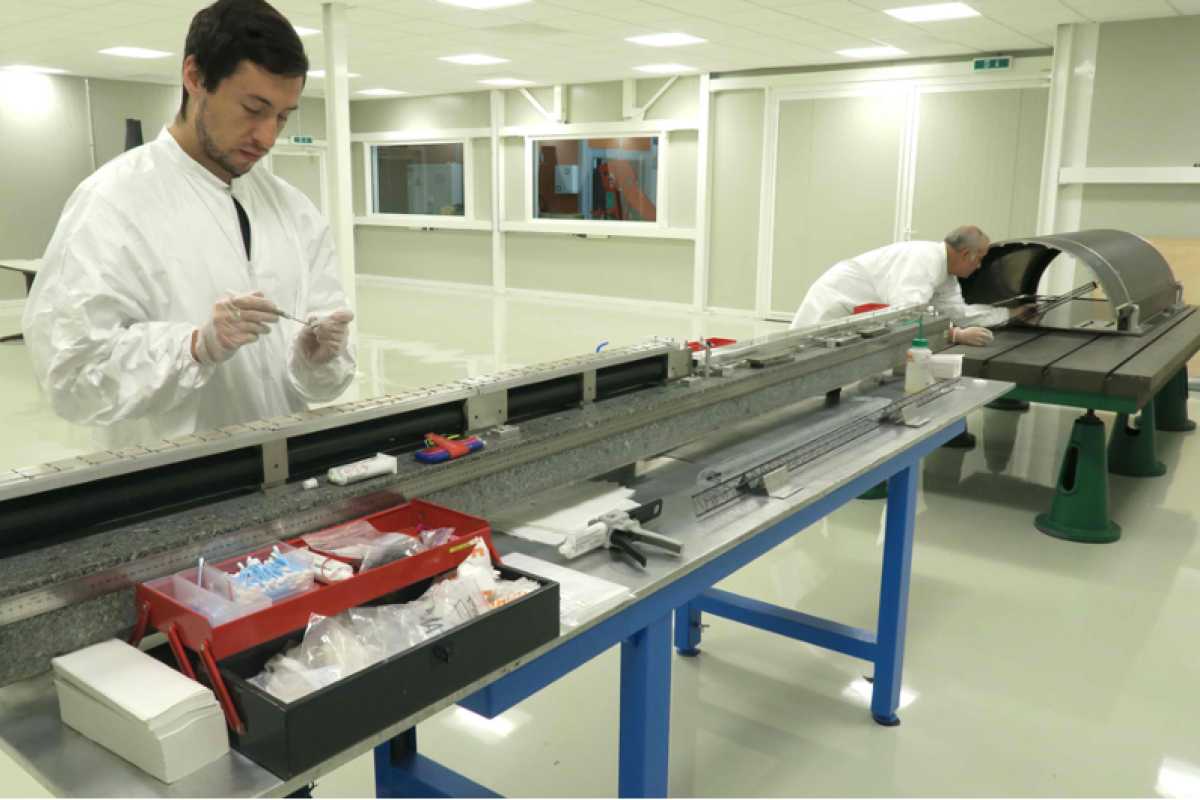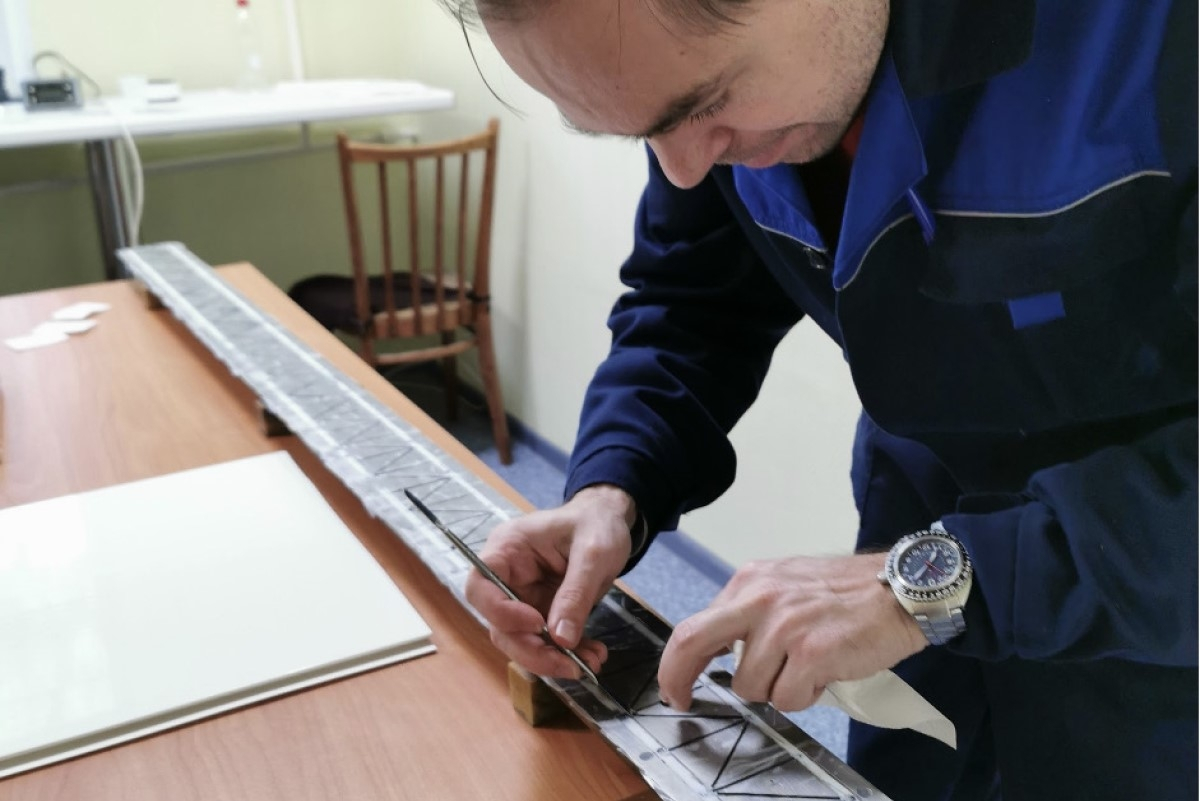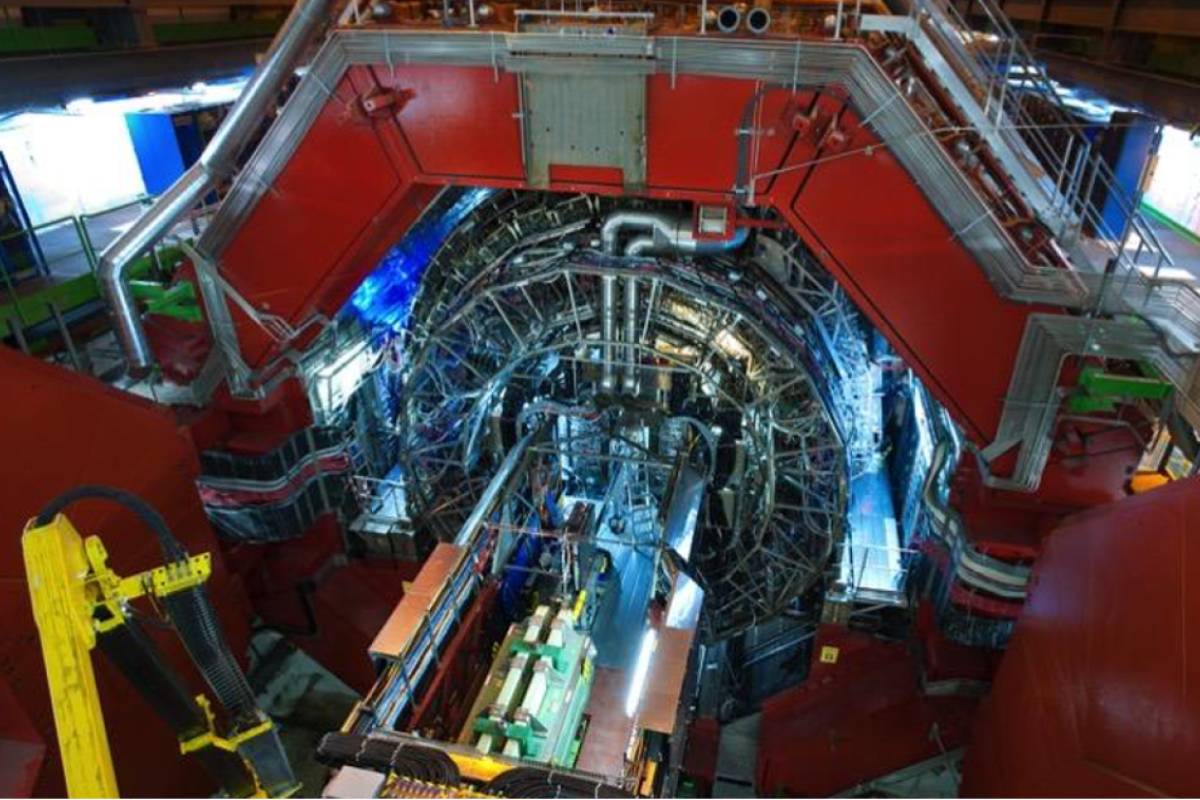From strangeness to charm: how scientists of St Petersburg University are engaged in CERN
For many years, physicists of St Petersburg University have been engaged in the Large Hadron Collider (LHC) experiments at the European Organization for Nuclear Research (CERN). Scientists of St Petersburg University were among the first to design the ALICE experiment to detect the quark-gluon plasma, i.e. the matter the early Universe is thought to consist of. This was followed by research into the nature of strong interaction in the NA61/SHINE experiment. In 2020, even during the fight against the pandemic, the latest new state-of-the-art inventions designed by the scientists at St Petersburg University were implemented in modifications of ALICE at the LHC.
The quark-gluon plasma (QGP) is an extreme state of matter. It is among the key areas of research at the LHC. As physical data have it, shortly after the Big Bang, the Universe was filled with an astonishingly hot, dense soup made of quarks and gluons.
To recreate conditions similar in the energy density to those of the very early Universe, A Large Ion Collider Experiment (ALICE) makes head-on ultra-relativistic collisions between nuclei. This forms the quark-gluon plasma. The ALICE collaboration uses the 10,000 ton ALICE detector – 26 m long, 16 m high, and 16 m wide. The ALICE installation is composed of a large number of sub-detectors. The detector sits in a vast cavern 56 m below ground, receiving beams from the LHC.
The ALICE collaboration has more than 1,933 scientists from 176 physics institutes in 39 countries, including a group of scientists, students and post-graduate students of the Laboratory of Ultra-High Energy Physics of St Petersburg University. Scientists of St Petersburg
University were among the first to design the detector and are now at the forefront of research to ensure it remains state-of-the-art.
In 1992, scientists of St Petersburg University became actively involved in the International Collaboration in Physics Research which focused on the LHC’s experiments. Our scientists came up with the ideas of how to design the very central part of the ALICE experiment to detect and study the quark-gluon plasma produced in head-on ultra-relativistic nucleus-nucleus collisions. Two of these ideas were global winners.
Grigory Feofilov, Head of the Laboratory of Ultra-High Energy Physics, Associate Professor in the Department of High Energy and Elementary Particles Physics of St Petersburg University. From 1992 to 2002, he led a project that focused on developing two central systems in the ALICE experiment.
‘Our ideas as to how to develop the central detector systems in the ALICE experiment were implemented at CERN. These systems surround the nucleus-nucleus collision point and promptly register particles including those composed of strange quarks. Theoretically, production of strange and multi-strange particles might be a sign of the quark-gluon plasma formation. Thus St Petersburg University is actively engaged in the ALICE collaboration at CERN,’ said Mr Feofilov.
St Petersburg University is also participating in the second fundamental CERN experiment. It is the NA61/SHINE (SPS Heavy Ion and Neutrino Experiment) at the Super Proton Synchrotron (SPS). The SPS is the second-largest machine in CERN’s accelerator complex. The NA61/SHINE studies the properties of the production of hadrons in collisions of different beam particles (pions, protons, beryllium, argon and xenon, etc.) with a variety of fixed nuclear targets. About 140 physicists from 14 countries and 28 institutions work in NA61/SHINE. Its main goals are to search for the critical point of strongly interacting matter and to study the onset of deconfinement.
‘We are driven by an enthusiasm to study ultrarelativistic hadron-hadron collisions in the processes of how the particles are produced, including strange and multi-strange particles. Today, we are part of the CERN’s NA61/SHINE collaboration to study the phase diagram of hadronic matter by a scan of particle production in collisions. This can provide a deeper understanding of heavy-ion events,' added Grigory Feofilov.
The group of scientists from St Petersburg University includes both highly experienced and early-career researchers, with 15 out of 30 being students and post-graduate students. In 2019 and 2020, St Petersburg University and two collaboartions at CERN produced about 87 publications in the world’s leading highly cited journals.
Charming ALICE’s «heart»
St Petersburg University was behind a project to develop and construct the Inner Tracking System (ITS) that finally reached its ultimate destination at the heart of ALICE. The ITS is the central detection system in the ALICE experiment. It took 16 years of development by an international team comprising 15 institutions from around the world, including St Petersburg University. The University was the only university to represent Russia in the given experiment at that time. The ITS is the ALICE’s innermost detecting system. It consists of about 10 square meters of ultra-thin silicon sensors (about 350 microns) surrounding the interaction point in 7 concentric layres. The ITS ensures high-precision of tracking and vertexing of strange and multi-strange hyperon decay.
‘This is mainly about the particles consisting of one, two, or three strange quarks. These particles decay after flying several centimetres from the point where they were produced. We must ensure the highest standards in design and construction of the ITS. They can be compared in some way with the standards that must be satisfied in designing and producing microscope lenses. It is about the maximum radiation transparency, i.e. the minimal material budget necessary for the particles getting out from the point of nucleus-nucleus collisions when traversing surrounding detector layers of the ITS. No such state-of-the-art solutions existed in 1992,’ said Grigory Feofilov.
‘It was an incredibly serious challenge. We had to ensure the minimal material budget in the working zone, to drain up to 10 kW of heat power, and to provide thermomechanical stability at the level of about 10 microns for all silicon sensors to detect the particles. This sysetm was developed by St Petersburg University in collaboration with St Petersburg’s leading institutions. Among them are CDBMB Rosatom, VNIIM, Avangard, Granit. The ITS was completed by the interanional collabotation and installed in 2008. It was this ITS that provided the very first physics data after the LHC start’ said Grigory Feofilov.
From 2008 to 2018, ALICE regularly received the LHC beams and detected collisions of protons and Pb ions accelerated to approximately the speed of light.
In 2020 the new tracking system for ALICE - the ITS2, was developed, and tests with the cosmic rays were started. Scientists at St Petersburg University proposed several ideas for the design of this new ITS2. The production of the ultra-lightweight carbon composite components of the ITS2 was organised at CERN, Tests of some silicon sensors performance were also done in Saint-Petersburg.
Among the key goals of the upgraded system is to detect the ‘charm’, i.e. to investigate the processes of the charmed particles production. For this reason, an upgraded system (ITS2) was designed by the ALICE collaboration to ensure the high-precision (below 100 microemeters) of detecting the particles with charm quarks. The Monolithic Active Pixel Sensors (MAPS) were applied to ensure the record level of radiation transparency. The upgraded ITS2 consists of 24,000 MAPS. They are 50 microns thick, 15 mm wide, and 30 mm in length each. A sensor consists of 512,000 pixels. Each pixel size is 28×28 microns2. Seven layers of these sensors around the interaction point cover an area of 10 m2.
Scientists at St Petersburg University proposed a solution to create ultra-lightweight carbon support structures with an embedded cooling system. They weight just several grams, yet their size is impressive. The panel of 1.5 metres in length can weight just 33 grams. These sensors ensure the record level of resolution for detecting and vertexing of particle decay that have charmed and beauty quarks. Scientists received patents of St Petersburg University for original technologies to create these ultra-lightweight, radiation-transparent, carbon support structures with an embedded cooling system.
Testing the upgraded ALICE ITS2 allowed to identify and eliminate failures that might hinder the tracking process later. Engineers at St Petersburg University developed also a solid and light carbon composite ‘rocket’. It supports the ITS2 structures and signal cables installed in the ALICE’s heart. ‘We have carried out the engineering experiments, and what we have designed and developed ensures the operation of the upgraded ITS2,’ said Grigory Feofilov.
The upgraded ITS2 has been testing 24/7. Scientists at St Petersburg University had 42 shifts in 2019 and 20 shifts in 2020, continuing to be at the forefront of research regardless of the restrictions due to the pandemic.
‘Even during the pandemic, the ALICE collaboration is continuing its intensive efforts to analyse the experimental data obtained in 2009–2018. Scientists presented their results at the conferences, mostly in the distance mode. In 2020, the ALICE collaboration produced over 30 publications in the world’s leading journals. It is not less than the number of publications produced annually in the pre-pandemic period’
Igor Alytsbeev, research associate in the Department of Nuclear Physics Research Methods at St Petersburg University and ALICE coordinator of the Physics Working Group on Correlations and Flow
Among the major research results achieved by scientists this year is obtaining highly precise data on interactions between protons and baryons that have strange quarks. These particles are produced in hadron-hadron interactions. They jet from the source that has a size of one femtometre, i.e. a unit of length equal to 10-15 metres. It enables scientists to carry out experiments on heavy-ion interactions. The precision is much higher than provided by the quantitative models of quantum chromodynamics.
‘These data are important for gaining a better understanding of the processes inside the neutron star interiors. Notably, St Petersburg University reviewed the article by ALICE Collaboration recently published in Nature that focused on these research findings. Besides, these results were possible to achieve thanks to the endeavours by scientists at St Petersburg University as they were behind the ITS project development’ said Igor Alytsbeev.
Apart from assembling and testing the ITS2 in 2020, scientists at St Petersburg University also developed ideas on how to optimise the ITS3. The ITS3 is based on the state-of-the-art ultra-thin (20 microns) silicon sensor that covers the area of 140×140 mm2. The system is designed to detect charmed mesons in the nucleus-nucleus collisions at the next stage of high-luminosity LHC planned in 2025. The new cooling system uses cold nitrogen gas or cooled dry air to ensure the minimum speed of the flow. This is important to eliminate vibration of thin sensors covering large areas.
A special focus is on how to eliminate condensate in the working zone. This is an area of research for both highly-experienced scientists and early-career researchers. Among them are postgraduate student Dmitrii Nesterov and master’s student Alina Rakhmatullina. In 2020, the ideas developed by scientists at St Petersburg University were submitted to be reviewed by the European Strategy for Particle Physics. St Petersburg University is planning to continue this research project in the years 2021 -- 2025, with collaboration with students and early-career researchers.
In 2021, modifying the LHC will result in a ten-fold increase in intensity of the beams. It will enable the detection of rare processes of charmed particles production. It will also provide a deeper understanding of the quark-gluon plasma.
Grigory Feofilov, Head of the Laboratory of Ultra-High Energy Physics, Associate Professor in the Department of High Energy and Elementary Particles Physics at St Petersburg University
‘What are the reasons behind our keen interest in charmed and beauty particles? The thing is that they contain rather heavy с- and b-quarks. This is the reason why they are not able to be formed in the hot quark-gluon plasma. The dominating trends in the rare processes of their production reflect the early hadron-hadron interactions. Presumably, these charmed particles will provide “a tool for the QGP tomography” and give us a better understanding of the quark-gluon plasma'.
‘Detecting’ how the particles are produced
Apart from the ALICE experiment, scientists at St Petersburg University are engaged in the NA61/SHINE experiment. The NA61/SHINE is the largest fixed target experiment to study how the particles are produced in the relativistic nucleus-nucleus collisions.
NA61/SHINE is a particle physics experiment at the Super Proton Synchrotron (SPS). The SPS is a relatively small LHC’s storage ring. Scientists at St Petersburg University made a considerable contribution for the NA61/SHINE in designing and developing a unique extra-light weight double layer wall beam pipe filled with helium gas This resulted in a ten-fold increase in the intensity of the heavy-ion beam. Additionally, they moved forward designing and developing a new type of the vertex detector. The NA61/SHINE collaboration and our scientists primarily focus on the phase transition from the hadron matter to the quark-gluon plasma. Besides, scientists at St Petersburg University are also engaged in the experiments to detect a critical point of the phase transition of the first type on the phase diagram of the strongly interacting nuclear mater.
Among the original research methods developed by St Petersburg University are the following. Firstly, it is an analysis of fluctuations and so-called long-range correlations between the observed values in the rather separated phase space regions. Secondly, it is a use of strongly intensive variables to determine the characteristics of the sources of the particles. Finally, it is the development of theoretical approaches towards an analysis of the correlation functions that may serve as a sign of a new physical phenomenon, i.e. a fusion of the quark-gluon strings.
Additionally, scientists proposed research methods to study correlations. Thus, we can obtain data on the initial stages of producing the quark-gluon plasma. It is important to gain a better understanding of how it may be evolving.
Developing new methods and theoretical approaches to analyse the obtained NA61/SHINE data is in the focus of successful early-career researchers at the Laboratory of Ultra-High
Energy Physics at St Petersburg University. Among them are postgraduate student Daria Prokhorova, Assistant Lecturer and Candidate of Physics and Mathematics Evgeny Andronov, and junior research associate Andrey Seriakov. In 2019, Andrey Seriakov became an official coordinator of popularising and organising visits to the NA61/SHINE experiment at CERN.
Big data and physics
Retrieving physical results from the data obtained in these experiments is painstaking and time-consuming. Postgraduate student Andrei Erokhin spent two years studying the experimental ALICE data on the proton-proton collisions at different energy levels produced by the LHC by using so-called strongly intensive variables, with the goal to exclude trivial fluctuations. Eventually, he obtained new data to prove a hypothesis of new type of particle sources that are produced in the proton-proton collisions at the LHC. These sources are characterised by the high energy densities due to the possible string clustering formation. Postgraduate student Svetlana Belokurova develops an original theoretical model that is based on the string clustering approach. The model provides an insight into the formation of the quark-gluon string clustering in the hadron-hadron collisions. This will give a deeper understanding of the physical effects.
Since 2016, our early-career researchers have also been focusing on how to apply machine learning (ML) methods to study the quark-gluon plasma. Big data and data mining are successfully used in commerce and banking. Now they are in physics as well.
Scientists use these methods to identify new properties of relativistic nucleus-nucleus collisions. ML methods are also used to improve the parameters of the physical models and effectiveness of tracking. Additionally, they can be used in detecting the types of particles and detecting the events depending on how central they are to the beam and even to find precise analytic solutions to the systems of equations. The research project is supported by grant No 17-72-20045 of the Russian Science Foundation. The head of the project is Igor Alytsbeev.
For over ten years, Andrey Zarochentsev, a research associate at the Laboratory of UltraHigh Energy Physics at St Petersburg University, has been working as a coordinator of all Russian websites that are responsible for storage and processing the ALICE data. This ensures a rapid access to and processing data received from the LHC. Additionally, it provides technical support for the Russian ALICE segment in the Worldwide LHC Computing Grid. Moreover, St Petersburg University is also behind the project to develop the DataLake in Russia.
‘Today, fundamental experiments are so arduous, that it is required to combine the joined efforts of theorists, experimenters, engineers, technologists, and IT specialists. Importantly, we engage our early-career researchers and students. What is aslo important is that our early-career researchers are responsible for preparing the next generation of physicists. In particular, they organise workshops and seminars for school pupils. Ensuring continuity of St Petersburg school of physics over time must be a very high priority with us,’ said Grigory Feofilov.





